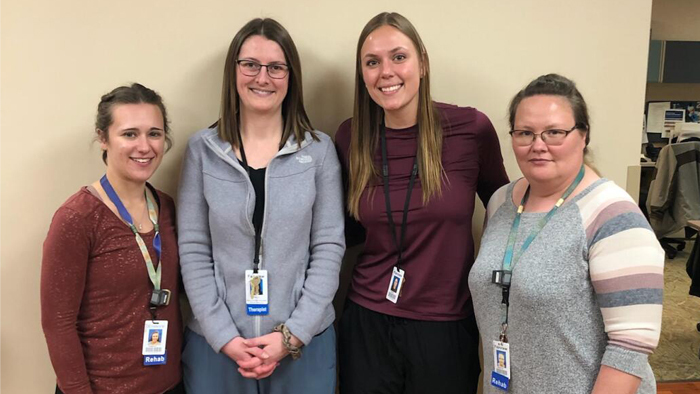Every day, you brush your teeth. You don’t even think about the action, it’s just a habit. But for many, simple, everyday things like this take work. Someone who has had a stroke, a concussion, surgery, or mental strains like anxiety or depression can find everyday tasks difficult. Thankfully, there are occupational therapists. In honor of National Occupational Therapy Month, we are diving into this integral service line and introducing you to our Occupational Therapy (OT) team, including the newest member, Emily Bounds.
Emily Bounds, who graduated with a master’s of occupational therapy from The College of St. Scholastica in 2022, joins Angela Doherty, Alberta Warwas, and Sara Smith who make up our OT team at Fairview Range. Doherty and Warwas both serve patients in the Behavioral Health inpatient unit and the Partial Hospitalization Program (PHP). Bounds and Smith work with patients in the outpatient or inpatient setting, so those who come from home or are currently hospitalized. Smith also sees clients at the Fairview Plaza who come in for pre-work screens.
What is occupational therapy?
“Occupational therapists focus on activities that people engage in on a daily basis as well as those that are very meaningful to the person or give them a sense of purpose or well-being. We provide education and interventions that address any deficit that may be impacting a person’s ability to live independently or participate in day-to-day life,” explains Bounds.
Occupational therapists are dedicated to improving people’s lives. This can include teaching skills that help patients acquire independence after an accident or injury or working with people with mental and physical delays on learning everyday skills like brushing their teeth or hair. OTs take in the whole person and their environment when providing advice and therapy.
How did occupational therapy get its start?
The roots of occupational therapy have been around for centuries. During the later half of the 1700s, society started to rethink the way people with disabilities and mental illness were treated. Before this, they were simply locked away. Over the next one hundred and fifty years, using “art and craft” skills with patients became a new standard. In 1914, George Edward Barton created the term occupational therapy after experiencing the treatment himself. Just three years later, the American Occupational Therapy Association (AOTA) got its start.
What is the difference between an Occupational Therapist (OT) and a Physical Therapist (PT)?
Both provide rehabilitation services but an OT is more about fine motor and mental skills. PT is all about movement. For example, a PT would focus on getting a patient back to walking properly while an OT would work on helping a patient to be able to dress themselves or make their bed.
What does an OT’s day look like?
“I work in the mental health realm of OT, so my typical day consists of facilitating groups in our inpatient unit and treating patients individually for things like cognitive impairments and coping skills,” explains Doherty. “One group is an exercise group, and the other group is typically focused on emotion regulation and self-care topics like healthy sleep habits, aromatherapy, mindfulness, meditation, and sensory modalities. I also facilitate a group in our Partial Hospitalization Program (PHP).”
“On Behavioral Health, we see patients individually but also facilitate groups on self-regulation and different aspects of wellness,” says Warwas. “We complete cognitive testing, assessing activities of daily living, fostering coping skills, aiding with routine building, life skill development, and fall risk/environmental modification.”
Smith adds, “A few days a week, I start in the hospital working with patients who are admitted. The other mornings, I start my day at the Fairview Plaza for an hour working with clients who come in for pre-work screens and then go back to the hospital to start treating inpatients. In the afternoon, I work with outpatient adults and pediatrics.”
A rewarding career
Every day is different and every day is busy. No matter what the day brings, it’s always rewarding for the OT team.
“It is very rewarding to help individuals increase their independence and engagement in things that they find most meaningful,” comments Bounds.
Every OT team member mirrored her thoughts. Through their work, each OT helps patients get back vital skills so they can return to what’s important to them. Having a purpose in life is so important and these women work hard to make sure each patient is on the right road to success.
If you or a family member think you may benefit from Occupational Therapy, speak with your primary care provider about getting a referral.



